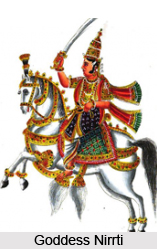 Goddess Nirrti has been mentioned in one hymn of Rig Veda. Nirrti`s name means "destruction." Nirrti manifests herself in decay, need, anger, old age, cowardice and death. She is the representative of the dark side to Vedic vision of feminine divinity. She is apparently dark and dressed in dark clothes according to Taittiriya Brahmana. Repeatedly she is given offering in order to keep her away from the sacrificial rituals as well as from general affairs of people.
Goddess Nirrti has been mentioned in one hymn of Rig Veda. Nirrti`s name means "destruction." Nirrti manifests herself in decay, need, anger, old age, cowardice and death. She is the representative of the dark side to Vedic vision of feminine divinity. She is apparently dark and dressed in dark clothes according to Taittiriya Brahmana. Repeatedly she is given offering in order to keep her away from the sacrificial rituals as well as from general affairs of people.
However, in Atharva Veda she is described to have golden locks. In the Shatapatha Brahmana she is related with pain and the south west corner is considered as her region. In it she is also mentioned as residing in the south that is the direction of kingdom of the dead.
In the Vedas, Nirrti is the daughter of Surabhi (the cow goddess), the wife of Adharma (Destroyer of All Things), and is the Goddess of Disease and Death. Nirrti means "misery" and is worshipped in order to dismiss disease. The ceremony dedicated to her comprises of use of black ornaments and the worshippers wear black garments. She is also considered as the goddess who punishes the sinners. However she also protects those borne into crime as long as they remain ethical. According to another source Nirriti is the Vedic goddess of death, the spouse of Nirrita, the guardian deity of the Southwest, and mother of Rakshasis and Rakshasa. She dwells in isolated places and watches those people who are hungry or in mourning.
This article is a stub. You can enrich by adding more information to it. Send your Write Up to content@indianetzone.com









